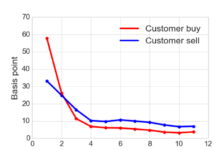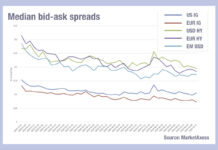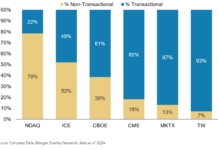A proposed pilot project for raising the size at which US bond trades must be reported, and delaying reporting for even larger trades, could lead to greater automation of trading, according to market professionals.
The pilot is being run by the Financial Industry Regulatory Authority (FINRA) based on recommendations from the Securities and Exchange Commission’s (SEC) Fixed Income Market Structure Advisory Committee (FIMSAC).
The proposed pilot is designed to study two recommendations. The first is increasing the current dissemination caps for corporate bond trades, from US$5 million to US$10 million for investment grade (IG) corporate bonds, and from US$1 million to US$5 million for non-IG corporate bonds.
As the SEC noted “This would result in the dissemination of additional size information for trades between the current and proposed caps.”
 Kevin McPartland, managing director at research firm Greenwich Associates wrote in an analyst note released yesterday, “To put the value of this extra data in perspective, on March 15, 2019 (a somewhat random day we chose as an example) 1,118 trades out of 63,895 trades were reported as $5m+ – 1.7% of the total. But those trades accounted for $13.1 billion out of $36.6 billion – nearly 36% of the total market that day. This can also be translated as $13.1 billion in trades done for which the market doesn’t have the whole story. I do believe there is a thing as too much transparency, but this change seems like a reasonable step forward.”
Kevin McPartland, managing director at research firm Greenwich Associates wrote in an analyst note released yesterday, “To put the value of this extra data in perspective, on March 15, 2019 (a somewhat random day we chose as an example) 1,118 trades out of 63,895 trades were reported as $5m+ – 1.7% of the total. But those trades accounted for $13.1 billion out of $36.6 billion – nearly 36% of the total market that day. This can also be translated as $13.1 billion in trades done for which the market doesn’t have the whole story. I do believe there is a thing as too much transparency, but this change seems like a reasonable step forward.”

That is likely to support greater low-touch electronic trading in US credit markets, says Paul Reynolds, head of fixed income at execution management system (EMS) provider TradingScreen.
“The only way that more trades will be done at larger size electronically is through data,” he says. “We see that in FX, equities and futures, it’s time we implemented that model [in fixed income].”
The second recommendation is delaying dissemination of any information about trades above the proposed dissemination caps for 48 hours, where currently they are delayed by just 15 minutes. This will allow banks to offload bonds on behalf of their customers with less market impact.
“It shows a little bit of sympathy for the guys who are taking risk, and you have to include them,” says Reynolds “This market does not work without dealers.”
For other market participants the benefit will be less McPartland noted. “Conversely, an argument can be made that smaller investors could see less price gapping if aggressive market reactions to reported big block trades decline – but that is something we need the pilot to confirm.”
He also observed that knock-on effects might include weakening the validity of index calculations for exchange traded funds and credit default swaps if big trades are not accounted for when end of day bond prices are set.
“And another interesting concern: after a dealer has done a block trade with delayed reporting for client A, can they tell client B? Or are they obligated to tell client B?” he asked.
FINRA’s consultation – https://www.finra.org/sites/default/files/notice_doc_file_ref/Regulatory-Notice-19-12.pdf – is open for comment until 11 June 2019.
©TheDESK 2019
TOP OF PAGE

























